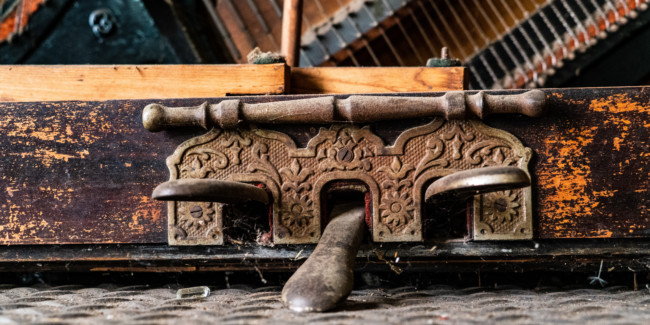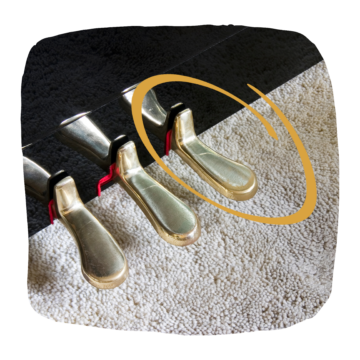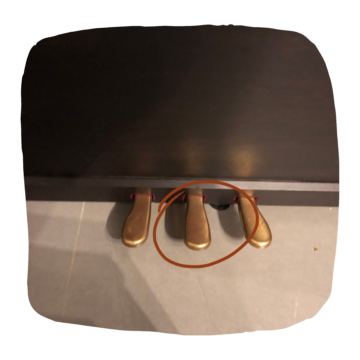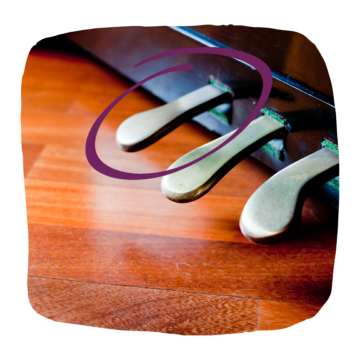Piano Pedals: Fully Explained

What do piano pedals do? Learn all about them in this guide.
For a professional piano player, the feet play a significant role. You may notice at the bottom of your piano that there are two or three pedals, usually made of brass. Each has a different role, each one an essential part of the piano sound. In this short article, we’ll explain different types of piano pedals and how to use them.
Types of piano pedals.
Pianos from the last 100 years have three pedals:
- The right one is the damper or sustain pedal
- The left is the soft pedal, known as una corda.
- The middle is a sostenuto pedal.
Let’s break them down further.

The right pedal: Damper pedal
Ladies and gentlemen, on the right, we have the damper pedal, more commonly known as the sustain. This is how it works.
This pedal controls the dampers, which are little felt pads that rest against the steel strings inside your piano. Every time you play a key, its damper is raised, and the strings vibrate with sound. When you release the key, the damper presses on the strings and stops the vibration. Pressing the damper pedal with your foot lifts all the dampers off the strings, and every note you play will be sustained and suspended in a colorful cacophony.
The sound of the sustain pedal is resonant and powerful, as it makes the notes blend. When there are too many notes at once, it becomes messy. Most piano players lift the pedal between chords or melodic phrases to clear the sound. This pedal is handy if you’re playing notes that are in the same key and will therefore blend beautifully.

The middle pedal: Sostenuto pedal
This pedal is a recent addition. Until the 20th century, pianos had two pedals — the right and the left. The center pedal is for more subtle purposes.
The sostenuto pedal has a selective sustain function because it only holds notes that you are already playing when you press the pedal down. Any notes you play after are not affected, allowing you to lengthen the resonance of some notes while having harmonic and melodic freedom in others.
The alternative use for the middle pedal is our personal favorite. It usually appears on upright pianos, and its function is to lower a piece of felt between the hammers and strings. It muffles the sound, instantly creating a cozy, melancholy, vintage feeling. It’s sometimes called a practice pedal because you use it for late-night playing sessions or repetitive practice that could be unsettling for fellow household members.
Some pianos still don’t have a center pedal; if they do, it is only for appearance.

The left pedal: Soft pedal
Most piano keys connect to strings in three groups, each tuned to the same pitch. When you press a key, the hammer strikes all three strings, making a strong resonant note.
When you press down on the una corda pedal of a grand piano, the entire hammer system shifts to the right, so only two out of three strings are struck for each key. Also, they are struck with a different part of the hammer – a gentler one. This makes the notes resonate softer and sparser.
Want to learn more about piano notes? Quickly Learn Piano Notes and Chords from our blog post.
On an older piano, the hammer would only hit one of the three strings, where the pedal gets its name, “una corda,” or “one string.”
When you’re playing the upright piano, this pedal moves the hammer system closer to the string, changing the force and momentum and creating a similar softening effect.
How to use the piano pedals.
With your feet flat on the floor, line them up so the big toes align with their pedals. When you want to use a pedal, place the ball of your foot on the end of the pedal. Keep the heel on the floor. Use your right foot for the sustain pedal and left for the sustain pedal.
- Half pedal: For a rich tone without any blur of sound, press gently on the sustain so that the dampers only lightly touch the strings.
- Simultaneous or rhythmic pedal: This is when you press and release the pedal simultaneously as you play a note or chord. It emphasizes the percussive element of the playing.
- Preliminary pedal: Press down the sustain before playing a note to lift the damper from the string before the hammer strikes. This deepens and thickens the tone and widens the resonance.
- Delayed/legato pedal: This is the way it’s most commonly used. Press the pedal down before the notes you wish to blend, and then release before the following melodic phrase or chord.
Don’t pedal too fast.
If you’ve still got your piano training wheels on, maybe it’s not quite time to introduce the pedals. This relatively advanced technique adds expressiveness and intention to your playing. Make sure you’re on top of the basics and have control over your fingers before you start trying to play with your feet.
In case you were wondering — yes — the Simply Piano app teaches you to play with your feet too!









